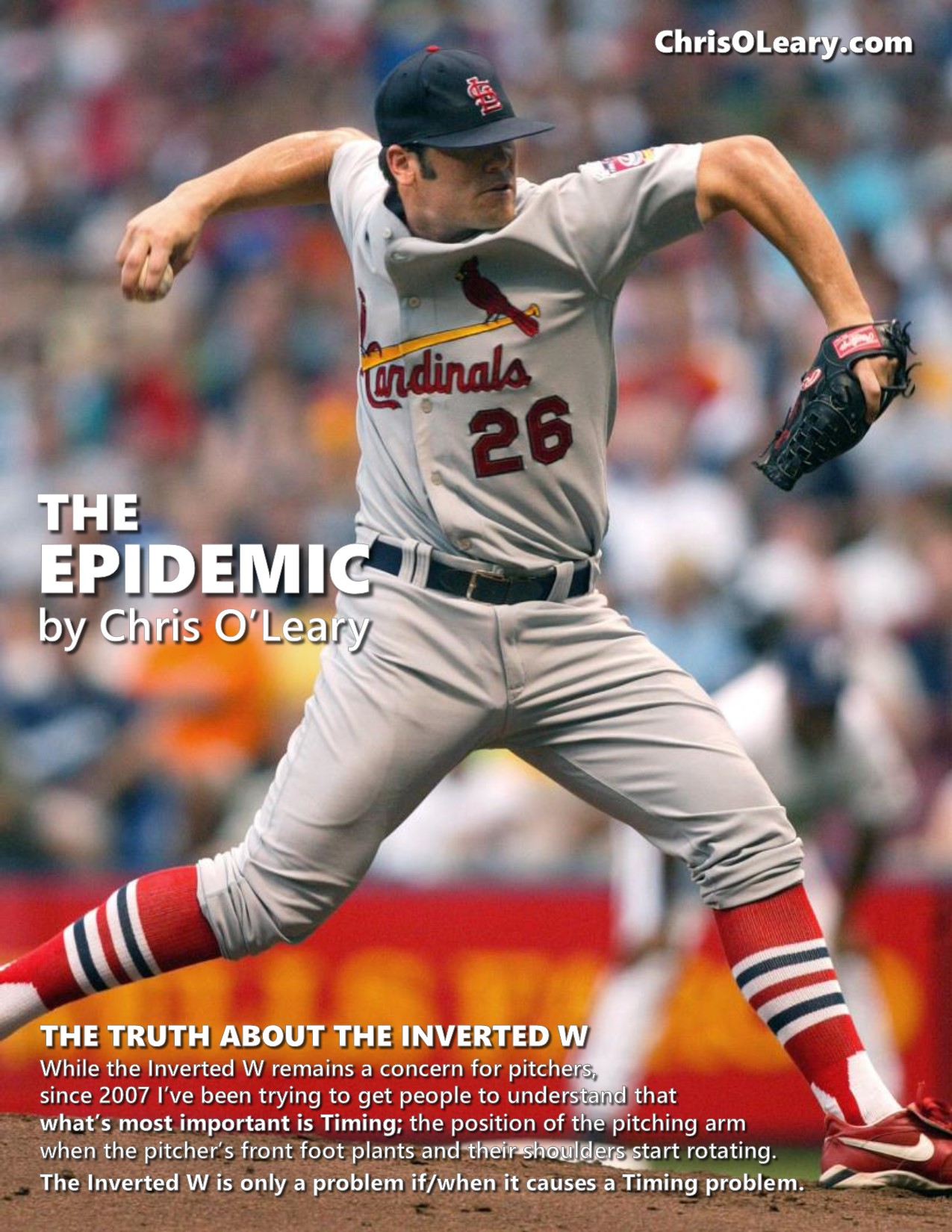| ChrisOLeary.com |
| ChrisOLeary.com > BUY > Pitching > Inverted Arm Actions |
|
My research into the problem with the Inverted Arm Actions dates back to early 2007, with my original piece on the inverted W. Just when I thought things we getting better, and pitchers and coaches are getting smarter, things are back in the toilet with the... What's so despicable is that Kyle Boddy of Driveline is now selling the arm action that got his own arm. And that I helped him fix. If you are new to the subject, I have put together an overview piece... ...that addresses what Jeff Passan said about the Inverted W, my work, and me in The Arm. TLDR As I've said since 2007, the Inverted W "isn't damaging in and of itself." It's only a problem if it hurts a pitcher's Timing. Which it tends to do. Inverted Arm ActionsThe Inverted W, which I initially called The M, is one of a number of pitching arm actions that I believe are one of the chief drivers of the pitcher injury and tommy john surgery epidemic because they can create a problem with a pitcher's Timing. And I mean can and not always does. As with the other inverted arm actions, which includes the Inverted L and the Inverted V, recent studies have shown that... Pitchers who make the Inverted W, and who have a Timing problem as a result, are at an elevated risk of experiencing shoulder and elbow problems. I use the term Flat Arm Syndrome to refer to the Timing problem that the Inverted Arm Actions tend to create. Why The Inverted Arm Actions Are BadLike the Inverted V and the Inverted L, the Inverted W is not (that) bad in and of itself. They don't directly lead to injuries. Instead, the problem with the Inverted Arm Actions is that they can create a Timing problem where the PAS forearm is not in the proper position at the moment the GS foot lands and the shoulders start to rotate. That will tend to increase the distance, and thus the force, with which the PAS upper arm externally rotates and increase the stress on both the elbow and the shoulder. 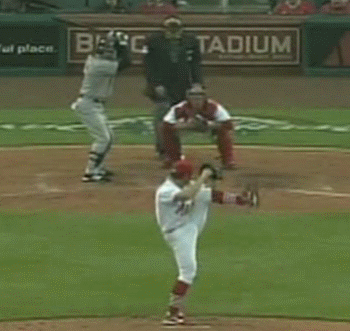
Anthony ReyesYou can see this Timing problem in the clip above of Anthony Reyes. The thing to notice is the position of Anthony Reyes' PAS forearm in Frame 41 at the moment his GS foot plants. Notice how Anthony Reyes' PAS forearm is horizontal, rather than vertical, in Frame 41. Anthony Reyes' PAS forearm isn't vertical until Frame 45, at which point his shoulders have rotated significantly. 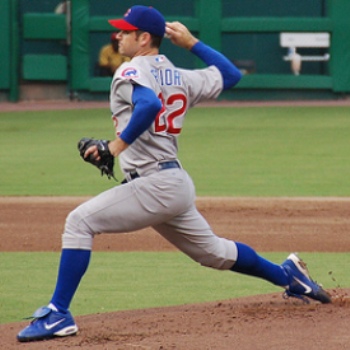
Mark PriorYou can see the same thing in the picture above of Mark Prior. The thing to notice is how much Mark Prior's shoulders have rotated, and how much his PAS elbow has pulled back, but his arm still hasn't reached 90 degrees of external rotation. That is the telltale of an arm that is quite late. 
Stephen StrasburgYou can also see a Timing problem in the picture above of Stephen Strasburg. Notice how his foot is planted and his shoulders are starting to rotate, but his arm isn't in the correct position. Instead of being UP at the moment his front foot plants, Stephen Strasburg's arm is FLAT. For obvious reasons, I call this Flat Arm Syndrome. Finally, it was Joba Chamberlain's pitching mechanics that alerted me to importance of Timing, rather than the mere position of the arms, to pitching injuries. Biomechanically SpeakingI go into greater detail about the scientific basis for why the Inverted Arm Actions are problematic elsewhere, but if you are interested in a more technical, anatomically-based explanation of why I think this is a problem, then let me give you one in the form of an e-mail I received in April of 2007... Chris, I am an orthopedic surgeon, and would like to offer you a theory on why the Inverted W is bad for the long term health of the shoulder. In the position of hyperabduction, elevation and extension of the distal humerus above the shoulder (inverted W) the inferior glenohumeral ligament is placed on stretch. The humeral head must lever against it to advance the arm forward. This ligament is the primary anterior stabilizer of the glenohumeral joint with the arm elevated (i.e. pitching). In other words, this position places this ligament under tension, then it is levered against in order to throw. This eventually will either loosen the shoulder, or tear the anterior labrum. It should be recognized this ligament is under stress during the "normal" delivery. If you traumatically dislocate your shoulder, this ligament is a key part of the pathology. Shoulder instability in turn leads to impingement, and other problems. Conversely, when the elbow is below the shoulder, this ligament would not be as stressed. Also, the specific use and timing of the muscles about the shoulder is critical. They have done muscle activity studies during throwing, and there are distinct differences between amateurs and professionals. There is also evidence for muscle use differences in the healthy shoulders, and the ones that aren't. I'm not sure he's exactly right about why this is bad, but what he says is interesting enough to make me think I'm on to something. Recognizing The Inverted Arm ActionsIf you look at the arm actions of pitchers like Randy Johnson, Nolan Ryan, and Greg Maddux, you will see that their Pitching Arm Side (PAS) elbows never get above the level of their shoulders. 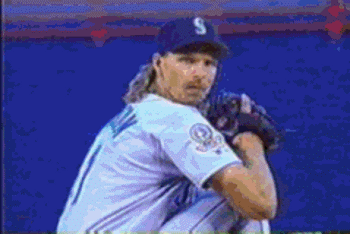
Randy JohnsonYou can clearly see this in the video clip above of Randy Johnson. While at first blush it looks like his PAS elbow gets quite high, if you take into account the fact that Randy Johnson leans forward toward First Base during his stride, you will see that his PAS elbow actually stays well below the level of his shoulders (the yellow line in Frames 43 and 49). You can also see this in the photos below of Nolan Ryan and Greg Maddux. 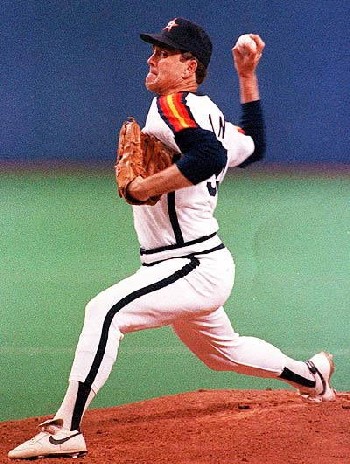
Nolan Ryan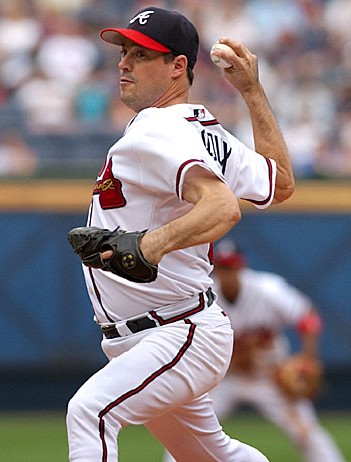
Greg MadduxNotice how their PAS elbows are well below the level of their shoulders after they break their hands. 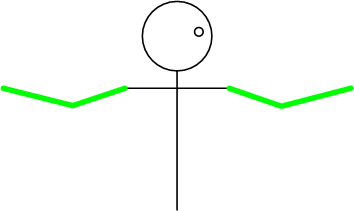
The Standard WIn particular, at the point of maximum scapular loading their elbows are below the level of the shoulders and the hand. This forms the shape of a "W" (the green lines in the diagram above). 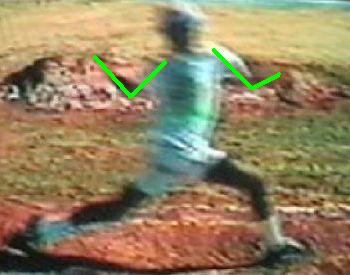
Greg MadduxThis is visible in video clips of Greg Maddux. You can also see the same thing in still photos of Greg Maddux. 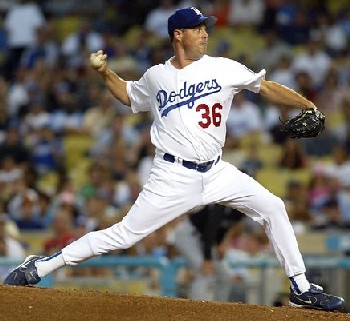
Greg MadduxIn contrast, if you look at the arm actions of pitchers like Mark Prior and Anthony Reyes, you will see that, after they break their hands, their elbows go above and behind the level of their shoulders. 
Mark PriorViewed from the side, this forms the shape of an Inverted W (the red lines in the diagram below). 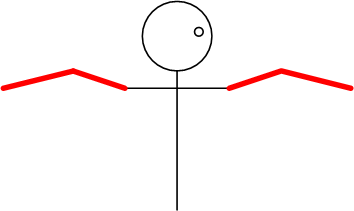
The Inverted WSome people will argue that I am comparing apples and oranges because what I am describing are two different points in time when I compare the Standard W to the Inverted W. While this is true, it doesn't matter for two reasons. First, pitchers who make the Standard W never let their elbows get above the level of their shoulders. Second, the problem with making the Inverted W is that it increases the distance and force with which the PAS upper arm will externally rotate. This increases the stress on both the elbow and the shoulder. Points Of ConfusionThere is some confusion among my readers about exactly what is (or isn't) an Inverted Arm Action and who exhibits one (or doesn't). One example of a player about which there is confusion, possibly due to prior confusion or lack of clarity on my part, is Carlos Marmol of the Cubs. 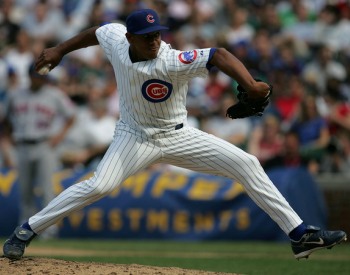
Carlos MarmolWhile it looks like Carlos Marmol is making the Inverted W in the photo above, I do not think he actually is. That is because he is leaning forward toward Third Base in this photo. As with Randy Johnson, that makes his PAS elbow look quite high. However, his PAS elbow does not seem to actually get above the level of his shoulders, which is a key characteristic of the Inverted W. |
| about | contact | copyright | sitemap | liability policy |

